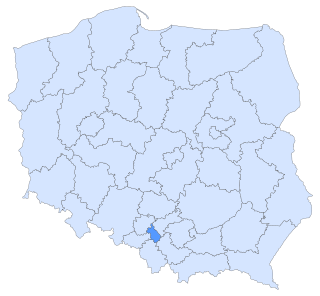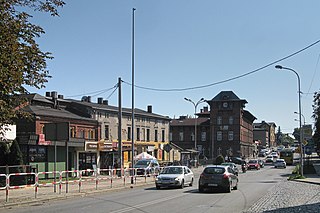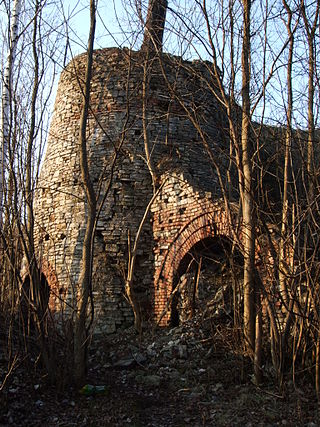
Silesian Voivodeship is a voivodeship, or province, in southern Poland centered on the historic region known as Upper Silesia, with Katowice serving as its capital.

Katowice is the capital city of the Silesian Voivodeship in southern Poland and the central city of the Katowice urban area. As of 2021, Katowice has an official population of 286,960, and a resident population estimate of around 315,000. Katowice is a central part of the Metropolis GZM, with a population of 2.3 million, and a part of a larger Katowice-Ostrava metropolitan area that extends into the Czech Republic and has a population of around 5 million people, making it one of the most populous metropolitan areas in the European Union.

Mysłowice is a city in Silesia in Poland, bordering Katowice. The population of the city as of 2022 is 72,124.

Kazimierz Julian Kutz was a Polish film director, author, journalist and politician, one of the representatives of the Polish Film School and a deputy speaker of the Senate of Poland.

Katowice Wojciech Korfanty Airport is an international airport, located in Pyrzowice, 30 km (19 mi) north of Katowice, Poland. The airport is named after Wojciech Korfanty, a politician of the early years of Polish independence. It is the fourth-busiest airport in Poland by passenger volumes, with 5.6 million passengers in 2023. It is also the second-busiest airport in the country by cargo volume and the largest origin of charter flights in Poland.

The Metropolis GZM is a metropolitan association composed of 41 contiguous municipalities in the Silesian Voivodeship of Poland. The seat of the metropolitan council is Katowice, the largest member city and the voivodeship capital. With a population of over 2 million, the core of the Metropolis GZM is one of the largest urban areas in the European Union. The area of the metropolis largely coincides with the metropolitan area of the Katowice urban area, which is a part of the wider cross-border Katowice-Ostrava metropolitan area, the latter with a population of 5–5.3 million people.

Kraków Główny, in English Kraków Main, is the largest and the most centrally located railway station in Kraków, Poland.

Expressway S86 – built from 1978 to 1986 section of national road 86 with a length of 5.9 kilometres (3.7 mi), connecting Katowice with Sosnowiec. In Katowice the road is a part of Walentego Roździeńskiego Avenue. The route has two carriageways, each with three lanes.

Transport in Kraków is based around a fairly dense network of tramway and bus lines operated by a municipal company, supplemented by a number of private minibus operators. Local trains connect some of the suburbs. The bulk of the city’s historic area has been turned into a pedestrian zone with golf buggies, rickshaws and horse buggies; however, the tramlines run within a three-block radius. Rail connections are available to most Polish cities. Trains to Warsaw depart every hour. International destinations include Berlin, Bratislava, Prague, Hamburg, Lviv, Kyiv, and Odesa (June–September). The main railway station is located just outside the Old Town District and is well-served by public transport.

Sejm Constituency no. 31 is a constituency of the Sejm in the Silesian Voivodeship, electing twelve deputies. It covers area of counties: Bieruń-Lędziny, Chorzów, Katowice, Mysłowice, Piekary Śląskie, Ruda Śląska, Siemianowice Śląskie, Świętochłowice and Tychy.

Dąbrowa Górnicza railway station is a railway station in Dąbrowa Górnicza, located in the Silesian Voivodeship, Poland. The station is situated in the city center at Kolejowa Street 3, close to key landmarks, including the Palace of Culture Zagłębie, Pogoria Shopping Center, and Fabryka Pełna Życia.

Kielce Bus Station is a bus station in Kielce, Poland. It is a novelty architecture type of a building, shaped to resemble a UFO. Opened in 1984, it was seen as one of the more modern bus stations of its kind in Poland at that particular time.
The Upper Silesian Railway was one of the earliest railways in Silesia. It connected Wrocław (Breslau) in Lower Silesia with Mysłowice (Myslowitz) in Upper Silesia. The first section was opened in 1842 and the last in 1846, after which it ran until merged into the Prussian state railways in 1883.

Brzezinka is a dzielnica (district) of Mysłowice, Silesian Voivodeship, southern Poland. It was previously an independent village and gmina, but was absorbed by Mysłowice in 1951.

Dziećkowice is a dzielnica (district) of Mysłowice, Silesian Voivodeship, southern Poland. It was previously an independent village, but was absorbed first by Tychy, and later in 1976 by Mysłowice.

The Katowice massacre or the Bloody Monday in Katowice that took place on 4 September 1939 was one of the largest war crimes of the Wehrmacht during its invasion of Poland. On that day, German Wehrmacht soldiers aided by the Freikorps militia executed about 80 of the Polish defenders of the city. Those defenders were self-defense militia volunteers, including former Silesian Insurgents, Polish Boy and Girl Scouts, and possibly a number of Polish soldier stragglers from retreating Polish regular forces who joined the militia.

Wrocław central bus station is a bus station in the Huby housing estate in Wrocław, Poland, located on floor -2 of the Wroclavia shopping center. It is adjacent to the Wrocław Główny railway station.

Katowice Załęże is a railway station in Katowice, located in the Załęże district in southern Poland. The stop, situated on the international E 30 railway line, was built in 1957, with scheduled train services beginning in 1966. Regional trains operated by Koleje Śląskie, traveling towards Częstochowa, Katowice, Lubliniec, and Gliwice, stop at this station.

Świeradów-Zdrój is a railway station in Świeradów-Zdrój, located in the southwestern part of the Lower Silesian Voivodeship.

Wojciech Korfanty Avenue in Katowice is a major arterial road running from the city center northward through the districts of Koszutka and Wełnowiec-Józefowiec, eventually leading to the neighboring city of Siemianowice Śląskie. Along the avenue, there are numerous public utility buildings and residential structures from various periods, particularly from the post-war era. The avenue is named after Wojciech Korfanty, a prominent figure in the history of Upper Silesia.





















